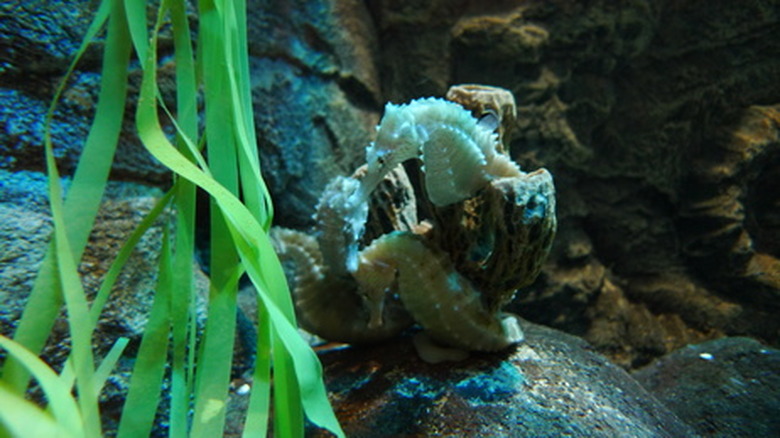How Do Seahorses Breathe?
Although seahorses may look very different from other types of fish, they are simply a genus of bony fishes with an upright swimming posture. Seahorses belong to the same class, Actinopterygii, as salmon, tuna and other familiar species. Like these fishes, seahorses absorb oxygen from water using delicate epidermal membranes known as gills.
The Operculum
A bony structure known as the operculum covers the gills of most fish species, leaving crescent-shaped openings at the sides of the head. In the seahorse, this structure is reduced to a narrow opening located at the back of the head. Ichthyologists do not fully understand the purpose of this evolutionary modification, but believe it to be related to the fish's characteristic elongated snout.
Tufted Gills
Seahorse gills have a distinctive internal structure as well. The common gill structure among bony fishes involves four gill arches on each side, arranged in an orderly fashion along cartilaginous filaments. Seahorse gills occur in a seemingly random tufted pattern, possibly as an adaptation to the modified head structure and reduced opercular opening.
The Lamellae
A small stem topped by a sphere of tissue makes up each tuft within a seahorse's gills. These tufts are the lamellae, a type of specialized epithelium. A dense network of blood vessels runs through the lamellae, allowing oxygen and carbon dioxide to diffuse across the thin membranes between the seahorse's bloodstream and the surrounding water. This allows the seahorse to take in oxygen and get rid of carbon dioxide.
Direction of Blood Flow
Within the lamellae, the blood flows through the capillary network opposite the natural flow of water from the mouth to the operculum. Known as countercurrent flow, this arrangement increases the potential for gas exchange, allowing the seahorse to extract the maximum possible amount of oxygen from the water.
Seahorse Respiration
Seahorse respiration takes place by passive diffusion. Passive diffusion occurs when substances move across a membrane from regions of low concentration to regions of high concentration. When there is more oxygen in the surrounding water than in the seahorse's blood, the oxygen molecules will naturally pass from the water into the seahorse's bloodstream. Similarly, carbon dioxide diffuses from the bloodstream into the surrounding water. This mechanism allows the seahorse to extract oxygen from its environment and dispose of waste gases.
References
- "Animal Diversity"; Cleveland P. Hickman, Jr, Larry S. Roberts and Allan Larson; 2000
- "Biology"; Neil A. Campbell, Jane B. Reece and Lawrence G. Mitchell; 1999
- "The Physiology of Fishes"; David Hudson Evans and James B. Claiborne; 2006
- Smithsonian Marine Station at Fort Pierce: Lined Seahorse
Cite This Article
MLA
Gray, Catherine. "How Do Seahorses Breathe?" sciencing.com, https://www.sciencing.com/do-seahorses-breathe-6592742/. 22 November 2019.
APA
Gray, Catherine. (2019, November 22). How Do Seahorses Breathe?. sciencing.com. Retrieved from https://www.sciencing.com/do-seahorses-breathe-6592742/
Chicago
Gray, Catherine. How Do Seahorses Breathe? last modified March 24, 2022. https://www.sciencing.com/do-seahorses-breathe-6592742/
